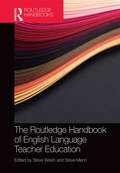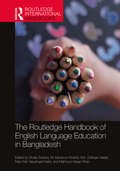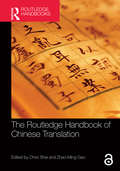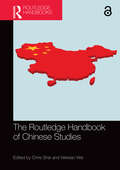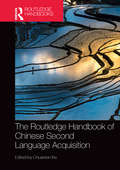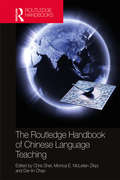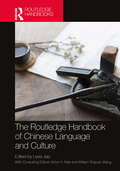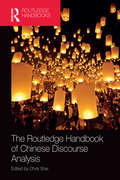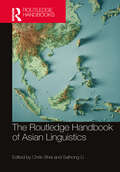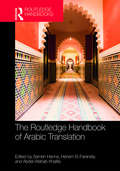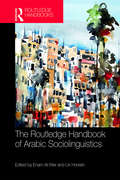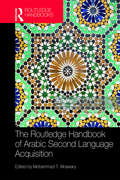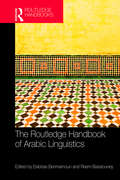- Table View
- List View
The Routledge Handbook of English Language Teacher Education (Routledge Handbooks in Applied Linguistics)
by Steve Walsh Steve MannThe Routledge Handbook of English Language Teacher Education provides an accessible, authoritative, comprehensive and up-to-date resource of English language teacher education. With an overview of historical issues, theoretical frameworks and current debates, this handbook provides unique insights into a range of teacher education contexts, focusing on key issues relating to teacher and learner priorities, language and communication, current practices, reflective practice, and research. Key features include: a cross-section of current theories, practices and issues, providing readers with a resource which can be used in a variety of contexts; the use of data, transcripts and tasks to highlight and illustrate a range of practices, including examples of ‘best practice’; ‘snapshots’ of ELTE from a number of contexts taken from all around the world; and examples of current technological advances, contemporary thinking on reflective practice, and insights gained from recent research. This wide-ranging and international collection of chapters has been written by leading experts in the field. The Routledge Handbook of English Language Teacher Education is sure to be core reading for students, researchers and educators in applied linguistics, TESOL and language education.
The Routledge Handbook of English Language Education in Bangladesh (Routledge International Handbooks of Education)
by Shaila Sultana M. Moninoor Roshid Md. Zulfeqar Haider Mian Md. Naushaad Kabir Mahmud Hasan KhanThis Handbook is a comprehensive overview of English language education in Bangladesh. Presenting descriptive, theoretical, and empirical chapters as well as case studies, this Handbook, on the one hand, provides a comprehensive view of the English language teaching and learning scenario in Bangladesh, and on the other hand comes up with suggestions for possible decolonisation and de-eliticisation of English in Bangladesh. The Handbook explores a wide range of diverse endogenous and exogenous topics, all related to English language teaching and learning in Bangladesh, and acquaints readers with different perspectives, operating from the macro to the micro levels. The theoretical frameworks used are drawn from applied linguistics, education, sociology, political science, critical geography, cultural studies, psychology, and economics. The chapters examine how much generalisability the theories have for the context of Bangladesh and how the empirical data can be interpreted through different theoretical lenses. There are six sections in the Handbook covering different dynamics of English language education practices in Bangladesh, from history, policy and practice to assessment, pedagogy and identity. It is an invaluable reference source for students, researchers, and policy makers interested in English language, ELT, TESOL, and applied linguistics.
The Routledge Handbook of English Language Education in Bangladesh (Routledge International Handbooks of Education)
by Shaila Sultana M. Moninoor Roshid Zulfeqar Haider Mian Naushaad Kabir Mahmud Hasan KhanThis Handbook is a comprehensive overview of English language education in Bangladesh. Presenting descriptive, theoretical, and empirical chapters as well as case studies, this Handbook, on the one hand, provides a comprehensive view of the English language teaching and learning scenario in Bangladesh, and on the other hand comes up with suggestions for possible decolonisation and de-eliticisation of English in Bangladesh. The Handbook explores a wide range of diverse endogenous and exogenous topics, all related to English language teaching and learning in Bangladesh, and acquaints readers with different perspectives, operating from the macro to the micro levels. The theoretical frameworks used are drawn from applied linguistics, education, sociology, political science, critical geography, cultural studies, psychology, and economics. The chapters examine how much generalisability the theories have for the context of Bangladesh and how the empirical data can be interpreted through different theoretical lenses. There are six sections in the Handbook covering different dynamics of English language education practices in Bangladesh, from history, policy and practice to assessment, pedagogy and identity. It is an invaluable reference source for students, researchers, and policy makers interested in English language, ELT, TESOL, and applied linguistics.
The Routledge Handbook of Chinese Translation (Routledge Language Handbooks)
by Chris Shei Zhao-Ming GaoThe Routledge Handbook of Chinese Translation presents expert and new research in analysing and solving translation problems centred on the Chinese language in translation. The Handbook includes both a review of and a distinctive approach to key themes in Chinese translation, such as translatability and equivalence, extraction of collocation, and translation from parallel and comparable corpora. In doing so, it undertakes to synthesise existing knowledge in Chinese translation, develops new frameworks for analysing Chinese translation problems, and explains translation theory appropriate to the Chinese context. The Routledge Handbook of Chinese Translation is an essential reference work for advanced undergraduate and postgraduate students and scholars actively researching in this area.
The Routledge Handbook of Chinese Translation (Routledge Language Handbooks)
by Chris Shei Zhao-Ming GaoThe Routledge Handbook of Chinese Translation presents expert and new research in analysing and solving translation problems centred on the Chinese language in translation. The Handbook includes both a review of and a distinctive approach to key themes in Chinese translation, such as translatability and equivalence, extraction of collocation, and translation from parallel and comparable corpora. In doing so, it undertakes to synthesise existing knowledge in Chinese translation, develops new frameworks for analysing Chinese translation problems, and explains translation theory appropriate to the Chinese context. The Routledge Handbook of Chinese Translation is an essential reference work for advanced undergraduate and postgraduate students and scholars actively researching in this area.
The Routledge Handbook of Chinese Studies
by Chris Shei and Weixiao WeiThis Handbook approaches Chinese Studies from an interdisciplinary perspective while attempting to establish a fundamental set of core values and tenets for the subject, in relation to the further development of Chinese Studies as an academic discipline. It aims to consolidate the current findings in Chinese Studies, extract the essence from each affiliated discipline, formulate a concrete set of ideas to represent the ‘Chineseness’ of the subject, establish a clear identity for the discipline and provide clear guidelines for further research and practice. Topics included in this Handbook cover a wide spectrum of traditional and newly added concerns in Chinese Studies, ranging from the Chinese political system and domestic governance to international relations, Chinese culture, literature and history, Chinese sociology (gender, middle class, nationalism, home ownership, dating) and Chinese opposition and activism. The Handbook also looks at widening the scope of Chinese Studies (Chinese psychology, postcolonialism and China, Chinese science and climate change), and some illustrations of innovative Chinese Studies research methods. The Routledge Handbook of Chinese Studies is an essential reference for researchers and scholars in Chinese Studies, as well as students in the discipline.
The Routledge Handbook of Chinese Studies
by Chris Shei Weixiao WeiThis Handbook approaches Chinese Studies from an interdisciplinary perspective while attempting to establish a fundamental set of core values and tenets for the subject, in relation to the further development of Chinese Studies as an academic discipline. It aims to consolidate the current findings in Chinese Studies, extract the essence from each affiliated discipline, formulate a concrete set of ideas to represent the ‘Chineseness’ of the subject, establish a clear identity for the discipline and provide clear guidelines for further research and practice. Topics included in this Handbook cover a wide spectrum of traditional and newly added concerns in Chinese Studies, ranging from the Chinese political system and domestic governance to international relations, Chinese culture, literature and history, Chinese sociology (gender, middle class, nationalism, home ownership, dating) and Chinese opposition and activism. The Handbook also looks at widening the scope of Chinese Studies (Chinese psychology, postcolonialism and China, Chinese science and climate change), and some illustrations of innovative Chinese Studies research methods. The Routledge Handbook of Chinese Studies is an essential reference for researchers and scholars in Chinese Studies, as well as students in the discipline.
The Routledge Handbook of Chinese Second Language Acquisition (Routledge Language Handbooks)
by Chuanren KeThe Routledge Handbook of Chinese Second Language Acquisition is the first reference work of its kind. The handbook contains twenty contributions from leading experts in the field of Chinese SLA, covering a wide range of topics such as social contexts, linguistic perspectives, skill learning, individual differences and learning settings and testing. Each chapter covers historical perspectives, core issues and key findings, research approaches, pedagogical implications, future research direction and additional references. The Routledge Handbook of Chinese Second Language Acquisition is an essential reference for Chinese language teachers and researchers in Chinese applied linguistics and second language acquisition.
The Routledge Handbook of Chinese Second Language Acquisition (Routledge Language Handbooks)
by Chuanren KeThe Routledge Handbook of Chinese Second Language Acquisition is the first reference work of its kind. The handbook contains twenty contributions from leading experts in the field of Chinese SLA, covering a wide range of topics such as social contexts, linguistic perspectives, skill learning, individual differences and learning settings and testing. Each chapter covers historical perspectives, core issues and key findings, research approaches, pedagogical implications, future research direction and additional references. The Routledge Handbook of Chinese Second Language Acquisition is an essential reference for Chinese language teachers and researchers in Chinese applied linguistics and second language acquisition.
The Routledge Handbook of Chinese Language Teaching
by Chris Shei Monica E McLellan Zikpi Der-Lin ChaoThe Routledge Handbook of Chinese Language Teaching defines Chinese language teaching in a pedagogical, historical, and contemporary context. Throughout the volume, teaching methods are discussed, including the traditional China-based approach, and Western methods such as communicative teaching and the immersion program. The Handbook also presents a pedagogical model covering pronunciation, tones, characters, vocabulary, grammar, and the teaching of listening, speaking, reading, and writing. The remaining chapters explore topics of language assessment, technology enhanced instruction, teaching materials and resources, Chinese for specific purposes, classroom implementation, social contexts of language teaching and language teaching policies, and pragmatics and culture. Ideal for scholars and researchers of Chinese language teaching, the Handbook will benefit educators and teacher training programs. This is the first comprehensive volume exploring the growing area of Chinese language pedagogy.
The Routledge Handbook of Chinese Language Teaching
by Chris Shei Monica E McLellan Zikpi Der-Lin ChaoThe Routledge Handbook of Chinese Language Teaching defines Chinese language teaching in a pedagogical, historical, and contemporary context. Throughout the volume, teaching methods are discussed, including the traditional China-based approach, and Western methods such as communicative teaching and the immersion program. The Handbook also presents a pedagogical model covering pronunciation, tones, characters, vocabulary, grammar, and the teaching of listening, speaking, reading, and writing. The remaining chapters explore topics of language assessment, technology enhanced instruction, teaching materials and resources, Chinese for specific purposes, classroom implementation, social contexts of language teaching and language teaching policies, and pragmatics and culture. Ideal for scholars and researchers of Chinese language teaching, the Handbook will benefit educators and teacher training programs. This is the first comprehensive volume exploring the growing area of Chinese language pedagogy.
The Routledge Handbook of Chinese Language and Culture (Routledge Language Handbooks)
by Liwei Jiao Victor H. Mair William Shiyuan WangThe Routledge Handbook of Chinese Language and Culture represents the first English anthology that delves into the fascinating and thought-provoking relationship between the Chinese language and culture, exploring various macro and micro perspectives.Chinese culture boasts a history of ten thousand years, while the Chinese language’s recorded history spans at least three thousand years, dating back to the Shang dynasty oracle bone inscriptions (OBI).This handbook is comprised of 17 chapters from 18 scholars including Victor Mair and William S-Y. Wang. Many chapters approach their respective topics with a comprehensive and historical outlook. Certain extensive subjects are addressed in multiple chapters, complementing one another. These topics include: The languages and peoples of China, and the southern Chinese dialects Mandarin’s evolution into a national language and its related writing reforms Language as a propaganda tool in the Cultural Revolution and in contemporary China Chinese idioms and colloquialisms This book offers an approachable exploration of the subject, appealing to both specialists and enthusiasts of the Chinese language and culture.
The Routledge Handbook of Chinese Language and Culture (Routledge Language Handbooks)
The Routledge Handbook of Chinese Language and Culture represents the first English anthology that delves into the fascinating and thought-provoking relationship between the Chinese language and culture, exploring various macro and micro perspectives.Chinese culture boasts a history of ten thousand years, while the Chinese language’s recorded history spans at least three thousand years, dating back to the Shang dynasty oracle bone inscriptions (OBI).This handbook is comprised of 17 chapters from 18 scholars including Victor Mair and William S-Y. Wang. Many chapters approach their respective topics with a comprehensive and historical outlook. Certain extensive subjects are addressed in multiple chapters, complementing one another. These topics include: The languages and peoples of China, and the southern Chinese dialects Mandarin’s evolution into a national language and its related writing reforms Language as a propaganda tool in the Cultural Revolution and in contemporary China Chinese idioms and colloquialisms This book offers an approachable exploration of the subject, appealing to both specialists and enthusiasts of the Chinese language and culture.
The Routledge Handbook of Chinese Discourse Analysis
by Chris SheiChinese is a discourse-oriented language and the underlying mechanisms of the language involve encoding and decoding so the language can be correctly delivered and understood. To date, there has been a lack of consolidation at the discourse level such that a reference framework for understanding the language in a top-down fashion is still underdeveloped. The Routledge Handbook of Chinese Discourse Analysis is the first to showcase the latest research in the field of Chinese discourse analysis to consolidate existing findings, put the language in both theoretical and socio-functional perspectives, offer guidance and insights for further research and inspire innovative ideas for exploring the Chinese language in the discourse domain. The book is aimed at both students and scholars researching in the areas of Chinese linguistics and discourse analysis.
The Routledge Handbook of Chinese Discourse Analysis
by Chris SheiChinese is a discourse-oriented language and the underlying mechanisms of the language involve encoding and decoding so the language can be correctly delivered and understood. To date, there has been a lack of consolidation at the discourse level such that a reference framework for understanding the language in a top-down fashion is still underdeveloped. The Routledge Handbook of Chinese Discourse Analysis is the first to showcase the latest research in the field of Chinese discourse analysis to consolidate existing findings, put the language in both theoretical and socio-functional perspectives, offer guidance and insights for further research and inspire innovative ideas for exploring the Chinese language in the discourse domain. The book is aimed at both students and scholars researching in the areas of Chinese linguistics and discourse analysis.
The Routledge Handbook of Asian Linguistics
by Chris Shei Saihong LiThe Routledge Handbook of Asian Linguistics provides a comprehensive overview of the ways in which Asian languages should be conceptualized as a whole, the distinct characteristics of each language group, and the relationships and results of interactions between the languages and language families in Asia. Asia is the largest and the most populous continent on Earth, and the site of many of the first civilizations. This Handbook aims to provide a systematic overview of Asian languages in both theoretical and functional perspectives, optimally combining the two in intercultural settings. In other words, the text will provide a reference for researchers of individual Asian languages or language groups against the background of the entire range of Asian languages. Not only does the Handbook act as a reference to a particular language, it also connects each language to other Asian languages in the perspective of the entire Asian continent. Cultural roles and communicative functions of language are also emphasized as an important domain where the various Asian languages interact and shape each other. With extensive coverage of both theoretical and applied linguistic topics, The Routledge Handbook of Asian Linguistics is an indispensable resource for students and researchers working in this area.
The Routledge Handbook of Asian Linguistics
by Chris Shei Saihong LiThe Routledge Handbook of Asian Linguistics provides a comprehensive overview of the ways in which Asian languages should be conceptualized as a whole, the distinct characteristics of each language group, and the relationships and results of interactions between the languages and language families in Asia. Asia is the largest and the most populous continent on Earth, and the site of many of the first civilizations. This Handbook aims to provide a systematic overview of Asian languages in both theoretical and functional perspectives, optimally combining the two in intercultural settings. In other words, the text will provide a reference for researchers of individual Asian languages or language groups against the background of the entire range of Asian languages. Not only does the Handbook act as a reference to a particular language, it also connects each language to other Asian languages in the perspective of the entire Asian continent. Cultural roles and communicative functions of language are also emphasized as an important domain where the various Asian languages interact and shape each other. With extensive coverage of both theoretical and applied linguistic topics, The Routledge Handbook of Asian Linguistics is an indispensable resource for students and researchers working in this area.
The Routledge Handbook of Arabic Translation
Translation-related activities from and into Arabic have significantly increased in the last few years, in both scope and scale. The launch of a number of national translation projects, policies and awards in a number of Arab countries, together with the increasing translation from Arabic in a wide range of subject areas outside the Arab World – especially in the aftermath of the Arab Spring – have complicated and diversified the dynamics of the translation industry involving Arabic. The Routledge Handbook of Arabic Translation seeks to explicate Arabic translation practice, pedagogy and scholarship, with the aim of producing a state-of-the-art reference book that maps out these areas and meets the pedagogical and research needs of advanced undergraduate and postgraduate students, as well as active researchers.
The Routledge Handbook of Arabic Translation
Translation-related activities from and into Arabic have significantly increased in the last few years, in both scope and scale. The launch of a number of national translation projects, policies and awards in a number of Arab countries, together with the increasing translation from Arabic in a wide range of subject areas outside the Arab World – especially in the aftermath of the Arab Spring – have complicated and diversified the dynamics of the translation industry involving Arabic. The Routledge Handbook of Arabic Translation seeks to explicate Arabic translation practice, pedagogy and scholarship, with the aim of producing a state-of-the-art reference book that maps out these areas and meets the pedagogical and research needs of advanced undergraduate and postgraduate students, as well as active researchers.
The Routledge Handbook of Arabic Sociolinguistics
by Enam Al-Wer Uri HoreshThe Routledge Handbook of Arabic Sociolinguistics comprises 22 chapters encompassing various aspects in the study of Arabic dialects within their sociolinguistic context. This is a novel volume, which not only includes the traditional topics in variationist sociolinguistics, but also links the sociolinguistic enterprise to the history of Arabic and to applications of sociolinguistics beyond the theoretical treatment of variation. Newly formed trends, with an eye to future research, form the backbone of this volume. With contributions from an international pool of researchers, this volume will be of interest to scholars and students of Arabic sociolinguistics, as well as to linguists interested in a concise, rounded view of the field.
The Routledge Handbook of Arabic Sociolinguistics
by Enam Al-Wer Uri HoreshThe Routledge Handbook of Arabic Sociolinguistics comprises 22 chapters encompassing various aspects in the study of Arabic dialects within their sociolinguistic context. This is a novel volume, which not only includes the traditional topics in variationist sociolinguistics, but also links the sociolinguistic enterprise to the history of Arabic and to applications of sociolinguistics beyond the theoretical treatment of variation. Newly formed trends, with an eye to future research, form the backbone of this volume. With contributions from an international pool of researchers, this volume will be of interest to scholars and students of Arabic sociolinguistics, as well as to linguists interested in a concise, rounded view of the field.
Routledge Handbook of Arabic Second Language Acquisition (Routledge Language Handbooks)
by Mohammad T. AlhawaryThe Routledge Handbook of Arabic Second Language Acquisition introduces major current approaches in Arabic second language acquisition (SLA) research and offers empirical findings on crucial aspects and issues to do with the learning of Arabic as a foreign language and Arabic SLA. It brings together leading academics in the field to synthesize existing research and develops a new framework for analyzing important topics within Arabic SLA. This handbook will be suitable as a reference work for advanced undergraduate and postgraduate students and scholars actively researching in this area and is primarily relevant to sister disciplines within teacher training and Arabic applied linguistics. The themes and findings should, however, also be attractive to other areas of study, including theoretical linguistics, psycholinguistics, cognition, and cognitive psychology.
Routledge Handbook of Arabic Second Language Acquisition (Routledge Language Handbooks)
by Mohammad T. AlhawaryThe Routledge Handbook of Arabic Second Language Acquisition introduces major current approaches in Arabic second language acquisition (SLA) research and offers empirical findings on crucial aspects and issues to do with the learning of Arabic as a foreign language and Arabic SLA. It brings together leading academics in the field to synthesize existing research and develops a new framework for analyzing important topics within Arabic SLA. This handbook will be suitable as a reference work for advanced undergraduate and postgraduate students and scholars actively researching in this area and is primarily relevant to sister disciplines within teacher training and Arabic applied linguistics. The themes and findings should, however, also be attractive to other areas of study, including theoretical linguistics, psycholinguistics, cognition, and cognitive psychology.
The Routledge Handbook of Arabic Linguistics (Routledge Language Handbooks)
by Elabbas Benmamoun Reem BassiouneyThe Routledge Handbook of Arabic Linguistics introduces readers to the major facets of research on Arabic and of the linguistic situation in the Arabic-speaking world. The edited collection includes chapters from prominent experts on various fields of Arabic linguistics. The contributors provide overviews of the state of the art in their field and specifically focus on ideas and issues. Not simply an overview of the field, this handbook explores subjects in great depth and from multiple perspectives. In addition to the traditional areas of Arabic linguistics, the handbook covers computational approaches to Arabic, Arabic in the diaspora, neurolinguistic approaches to Arabic, and Arabic as a global language. The Routledge Handbook of Arabic Linguistics is a much-needed resource for researchers on Arabic and comparative linguistics, syntax, morphology, computational linguistics, psycholinguistics, sociolinguistics, and applied linguistics, and also for undergraduate and graduate students studying Arabic or linguistics.
The Routledge Handbook of Arabic Linguistics (Routledge Language Handbooks)
by Elabbas Benmamoun Reem BassiouneyThe Routledge Handbook of Arabic Linguistics introduces readers to the major facets of research on Arabic and of the linguistic situation in the Arabic-speaking world. The edited collection includes chapters from prominent experts on various fields of Arabic linguistics. The contributors provide overviews of the state of the art in their field and specifically focus on ideas and issues. Not simply an overview of the field, this handbook explores subjects in great depth and from multiple perspectives. In addition to the traditional areas of Arabic linguistics, the handbook covers computational approaches to Arabic, Arabic in the diaspora, neurolinguistic approaches to Arabic, and Arabic as a global language. The Routledge Handbook of Arabic Linguistics is a much-needed resource for researchers on Arabic and comparative linguistics, syntax, morphology, computational linguistics, psycholinguistics, sociolinguistics, and applied linguistics, and also for undergraduate and graduate students studying Arabic or linguistics.
